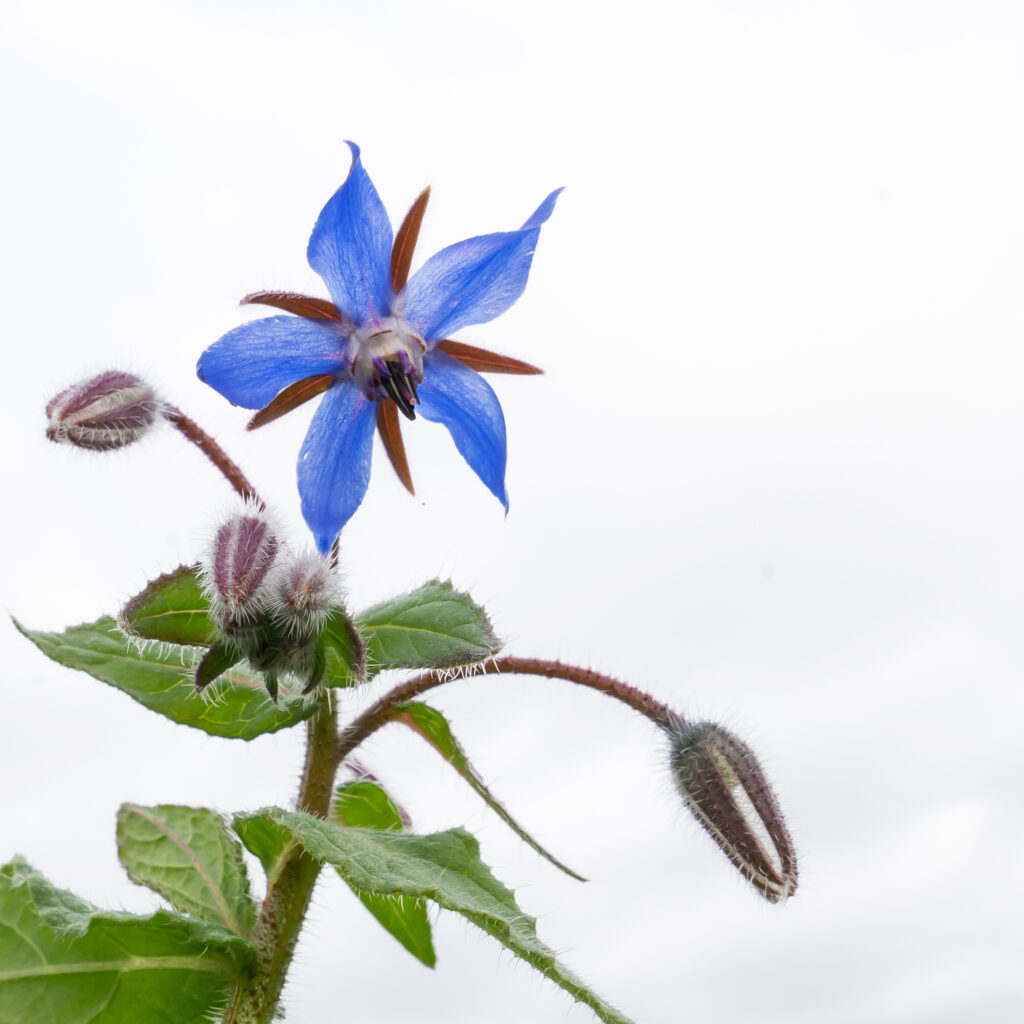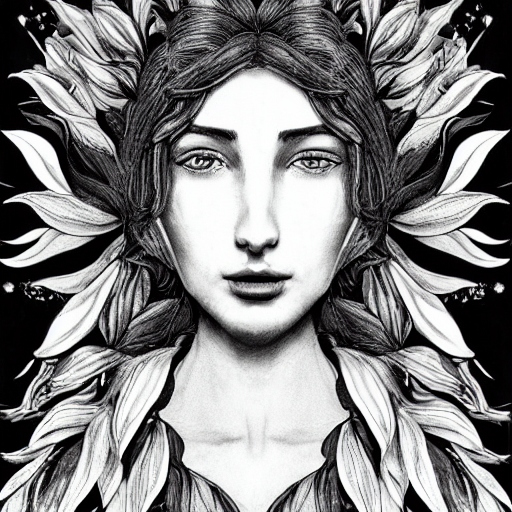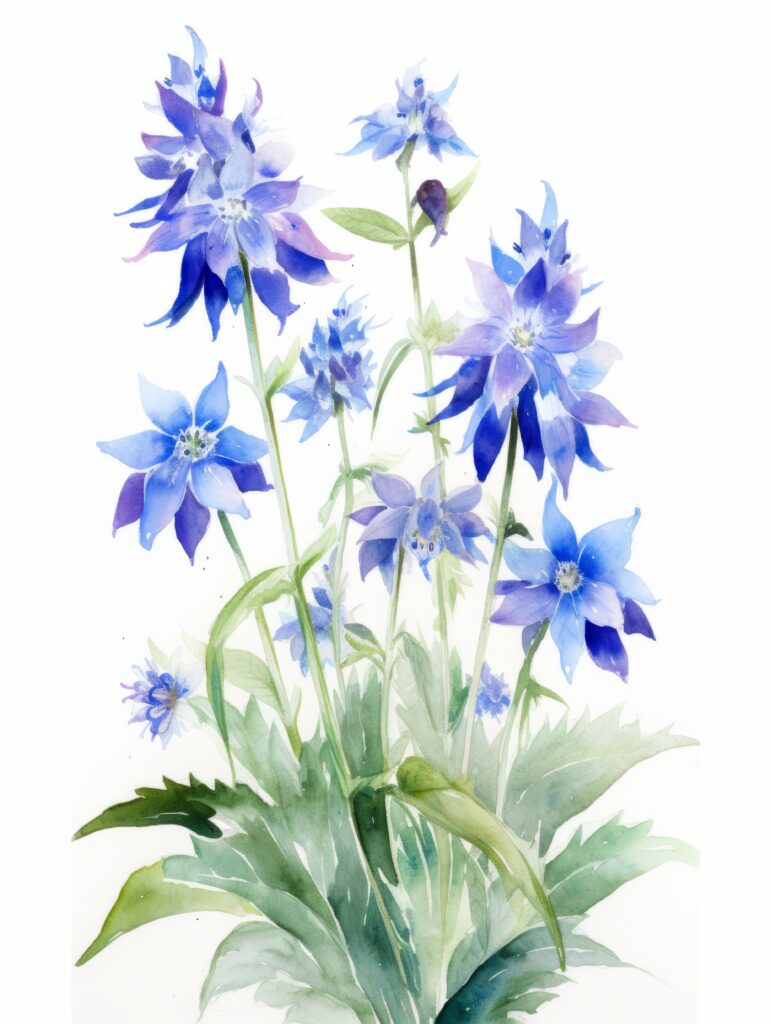Borage, with its daring blue flowers that burst forth against a backdrop of rugged, prickly foliage, has long been known as the “Herb of Gladness,” and for me it has embodied that very sentiment in a way I never expected. The connection between borage and happiness extends far beyond its historical roots; it is a living reminder that even in the midst of grief and sorrow, beauty can emerge, and joy can be nurtured—often from the most unlikely of sources.



When I lost my dear partner Jim in 2021, the world around me lost its color. I found myself wandering through my days in a state of perpetual mourning. It was during one of these days, while tending to my garden, that I came face-to-face with borage in a way that would f alter my relationship with both nature and my own healing process. There, standing tall and resilient, borage did not shy away from its rough, almost irritating foliage—even though its leaves sometimes pricked my skin when I gathered them—but its bright, brilliant blue flowers shone with an unmistakable beauty of optimism.
In those striking blue blossoms, I began to see echoes of Jim: the hardness of his exterior that had always protected a gentle, kind spirit, and the way his eyes, once full of life, now glowed with tender memories. The flowers were the color of his eyes. I saw in borage not just a plant, but a friend; I felt his presence in the delicate, defiant beauty of each bloom and in the way the leaves, though a little stingy, reminded me that life, with all its challenges, is also capable of profound tenderness.
There is something about borage that has always fascinated me. Its rough foliage, which at first can be quite abrasive when brushed against the skin, represents for me the thorny challenges we all face in life. Yet, when those obstacles are looked at from a different perspective, they too can offer a kind of startling beauty. The bright, cheerful blue flowers of borage provide an inspiring vision of optimism, an invitation to bask in the light even when darkness seems overwhelming. It is as if the plant itself is saying that pain and sorrow are not the end of the story, but rather necessary parts of a journey that ultimately leads to renewal and joy.
I often find myself wandering through my garden, and when I see borage thriving amidst dappled sunlight and softly whispering winds, I am reminded of its resilience. It can come up anywhere and everywhere now without me having to plant or sow seeds.
It is notoriously vigorous and self-seeding—its seeds, covered in delicate, silvery fuzz, cling stubbornly to your fingertips—they seem to symbolize the brave act of letting go. Those seeds, carried on dandelion-like puffs by the wind, serve as reminders that our pain, our sorrow, and our memories can be dispersed far and wide, enabling new growth and the promise of a new beginning. I have found that each time I carefully harvest a few leaves of borage, there is a bittersweet sensation—a sweet sting of remembrance mixed with the assurance that life continues in its most unpretentious yet astonishingly beautiful form.
While handling borage, the tactile sensation of its rough leaves would sometimes trigger a brief irritation—a reminder that even nature has its paradoxes. She has a particular sting. But those same leaves, when transformed into a soothing tea, release a flavor that is light, refreshing, and imbued with subtle hints of crisp cucumber. Sipping that borage tea made me feel like I was gently cradled in the arms of soothing nature,
It is known in the folklore of many cultures as a symbol of happiness and courage. Its luminous blue flowers have been celebrated by medieval knights, who believed that consuming borage before battle would lend them bravery and uplift their spirits. There is a romantic air to such traditions—a notion that even the humblest of plants can carry within it the power to change destinies, to transform fear into joy, and to inspire even in the bleakest moments. In my own life, I have often felt that borage offers a sort of gentle magic—a way of lifting the heavy cloak of sadness and replacing it with a fragile yet radiant thread of optimism. It is why, when the grief felt unbearable, I would wander outside and find comfort among the blooms, feeling as if each petal was a small beacon of hope, urging me to smile even when my tears seemed endless.
Borage holds numerous practical benefits that highlight its role as a powerful, holistic remedy. Medically, borage has long been valued for its anti-inflammatory properties, which can help soothe a range of physical discomforts from skin irritations to respiratory issues. The leaves and flowers are rich in gamma-linolenic acid (GLA), an essential fatty acid that actively combats inflammation and supports skin health. I remember a time when minor rashes and irritations that would have once caused me discomfort were soothed almost instantly with a gentle herbal tea made from borage. Its demulcent properties—its ability to coat and protect tissues—extend to the respiratory system as well, where it acts as an expectorant, easing coughs and clearing out stubborn mucus. In these ways, borage not only uplifts the spirit but also provides tangible, nurturing support to the body, helping to restore balance and vitality.
There is an exquisite duality in borage that mirrors our own inner complexities—it is both a reminder of life’s harsh challenges and a beacon of hopeful renewal. Its rough, sometimes stinging leaves symbolize the inevitable hardships we encounter, while its soft, vibrant blue flowers encapsulate the gentle, transformative power of joy. This dual nature resonates deeply with me, especially as I navigate the long shadows left by loss. With each encounter, borage reminds me that grief and healing are not opposing forces, but part of the same continuum—the tender interplay between sadness and the promise of better days. The sensation of borage’s leaves, despite their occasional abrasiveness, serves as a stirring reminder that even in our moments of pain, there is a beauty, a rawness, that is worth cherishing. It is this beauty, this unapologetic honesty, that invites us not only to mourn but to celebrate, to remember that from every fragment of sorrow, new strength and resilience can bloom.
Borage is also an ecological wonder. It is a dynamic accumulator, drawing valuable nutrients from deep in the soil and releasing them upon its decay, thereby enriching the earth for other plants. I’ve seen how borage, when allowed to grow wild, becomes a self-sustaining force in the garden, its vibrant blue blossoms attracting bees, butterflies, and other pollinators that help maintain the delicate balance of life in a garden. The seeds, adorned with fine, silvery fuzz, are expertly designed by nature to hitch a ride on passing creatures, ensuring that the dandelion-like dispersal of borage is not only effective but also beautifully emblematic of nature’s resilience. In this way, borage extends its influence, not only nourishing my soul with its beauty and medicinal properties but also sustaining the entire ecosystem through its interactions with soil microbes and pollinators.
I have spent many thoughtful hours in my garden, pondering the lessons hidden within the humble borage. I have learned that in order to experience healing and happiness, we must sometimes allow ourselves to feel deeply, to embrace even the temporary irritations that remind us of the challenges we face. Borage, in its gentle, stubborn way, has taught me that life’s most profound transformations often come from the willingness to accept both the pain and the beauty that coexist in every moment. Its vivid blue flowers, which seem to smile back at me even on my darkest days, are like a secret message from nature—a message that, despite all odds, there is always a way to find light.
Borage’s gentle cucumber-like flavor, when transformed into a warm herbal tea, carries with it the promise of a quiet, reflective sort of joy—a sip that feels like a tender reminder that life, with all its ups and downs, is a tapestry of experiences that contribute to our ultimate growth. Its taste is light and refreshing, with natural hints that evoke cool breezes and soft, sunlit days. Every time I drink borage tea, I am acutely aware of its ability to lift my spirits, to clear away the fog of sorrow for just a moment, so I can see with greater clarity the beauty that still exists around me.
This connection between borage and emotional healing is one that is deeply personal and profoundly moving. I treasure the way it transforms my state of mind, how its presence in my garden mirrors the journey of moving through grief toward a place of acceptance and eventual joy. Borage, with its rough and tender duality, teaches me that even when life chokes us with sorrow, there are still moments of grace waiting to be discovered—a moment when a bloom of brilliant blue reminds me that the essence of happiness lies not in a facade of perfection but in the raw, genuine pulse of life.
Borage also reminds me that the cycle of life is ever present. Its seeds, with their delicate silvery fuzz, scatter with abandon on the wind, promising new sprigs of life wherever they settle. It is as if borage is constantly writing its own story—a story of strength, upheaval, and renewal that mirrors our journeys through heartbreak and hope. With every seed that lands and every blossom that fades, borage whispers to me that there is beauty in impermanence, that every ending is simply the beginning of a new chapter. In that eternal cycle, I find a deep sense of connection—not only to the earth but to every soul that has ever faced loss and emerged, gently, into the light.
For me, borage is a living reminder that even in the midst of life’s harshest trials, there is still space for joy, for renewal, and for transformation. Every time I step into my garden and feel the prickly touch of its leaves, I am reminded that pain and pleasure are intertwined, that the sharpness of life’s challenges can coexist with the tender bloom of happiness. And as I continue to nurture my garden and, with it, my own soul, I am continuously bearing witness to the way that borage—this unexpected herald of delight—carries with it a promise of resilience. It teaches me that the path to healing is not about erasing our sorrows, but about feeling them deeply, and then letting them transform us into something stronger and more compassionate.
It is in this spirit of reverence and gentle transformation that I share with you one of my most cherished recipes—a Borage Bliss Elixir.
For this elixir, you will need
1/4 cup of fresh borage flowers,
1 tablespoon of fresh lavender flowers,
1 tablespoon of chamomile flowers,
1 tablespoon of raw honey,
1 cup of 40% alcohol (either brandy or vodka will do).
In a clean, sterilized jar, combine the fresh borage and lavender flowers along with the chamomile. Pour in the alcohol, making sure that all the flowers are fully submerged. Seal the jar tightly and store it in a cool, dark place for 4 to 6 weeks, remembering to shake it occasionally to mix the ingredients and allow the herbal essences to meld. After the infusion period, strain the mixture through cheesecloth or a fine-mesh sieve to remove the plant material. Once you have the clear, aromatic elixir, take 1 to 2 dropperfuls and mix it with some sparkling water to create a magical, uplifting beverage that not only delights the palate but also promotes joy, relaxation, and a sense of wonder.
Borage, with its rough leaves and brilliant blue blooms, is far more than just a common garden herb; it is a lasting emblem of resilience, a bearer of catharsis, and a testament to the eternal dance between sorrow and joy. Every time I encounter its delicate yet defiant beauty, I am reminded that life, in all its complexity, is an ever-evolving tapestry of pain, healing, memory, and hope. And in that truth, I find the strength to persevere, to allow the scars of loss to transform into pathways for new beginnings, and to trust in the gentle, unassuming magic of nature to guide me forward.




